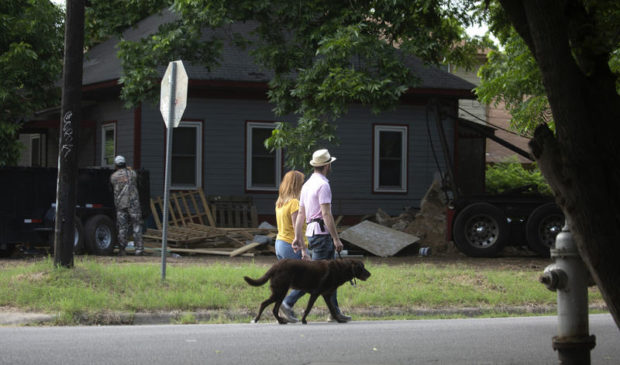In this East Austin neighborhood, there are now more dogs than children
Wednesday, May 30, 2018 by
Syeda Hasan In one rapidly changing East Austin neighborhood, dogs now outnumber children nearly two to one, according to a new report from the University of Texas’ Institute for Urban Policy Research and Analysis.
Researchers released the findings today in an addendum to a March 2018 report, which explored the effects of gentrification on longtime residents of East Austin. The study focused on one particular block between East Seventh and East 11th streets. Eric Tang, associate professor in the African and African Diaspora Studies Department at UT, said researchers kept hearing stories about the influx of dogs in the neighborhood, which seemed to coincide with the loss of children.
“This was the perception among long-standing residents,” Tang said. “We never measured that in our original survey, but we thought it was worth it to go back to the neighborhood after the first report was published to answer the question more definitively.”
Researchers returned to the neighborhood in April, asking residents of 171 single-family homes about their household pets, along with the number of children who lived in the residence. Apartments were excluded from the survey due to possible restrictions on pets. The findings released today confirm residents’ perceptions – researchers counted 116 dogs in the neighborhood and just 66 children.
Tang said the team also looked into data from the Austin Independent School District, which showed only six students living in the 1,930 new apartment units in the study area.
The loss of children coincides with other major demographic shifts happening in the neighborhood. It was once a central part of the city’s “Negro District,” created by Austin’s 1928 Master Plan, which relegated residents of color to the area east of Interstate 35.
Between 2000 and 2010, the neighborhood’s black population fell by 60 percent, while its Latino population dropped by 33 percent. Meanwhile, the white population jumped by 442 percent. There are also major economic changes at play. From 2000 to 2016, the area’s median family income grew from $28,929 to $69,570.
“So it’s not as if people are choosing not to have children because they can’t afford it,” Tang said. “What we find is that childlessness is kind of an index for higher incomes, economic and social homogeneity within the urban core, and ultimately, more economic segregation within the entire metropolitan area.”
Olivia Sullings, a recent UT graduate who worked on the study, said the team went into this latest survey expecting to find an overabundance of dogs. But ultimately, the rates of dog ownership in the neighborhood were more or less in line with the national average. About half of all American households have dogs.
“We were really, really surprised to actually find” that there weren’t an unusually high number of dogs, Sullings said. “It was the lack of children, and it just made it seem like there were so many dogs.”
Download (PDF, 139KB)
Photo by Jorge Sanhueza-Lyon/KUT. This story was produced as part of the Austin Monitor’s reporting partnership with KUT. This story has been updated.
The Austin Monitor’s work is made possible by donations from the community. Though our reporting covers donors from time to time, we are careful to keep business and editorial efforts separate while maintaining transparency. A complete list of donors is available here, and our code of ethics is explained here.
You're a community leader
And we’re honored you look to us for serious, in-depth news. You know a strong community needs local and dedicated watchdog reporting. We’re here for you and that won’t change. Now will you take the powerful next step and support our nonprofit news organization?










